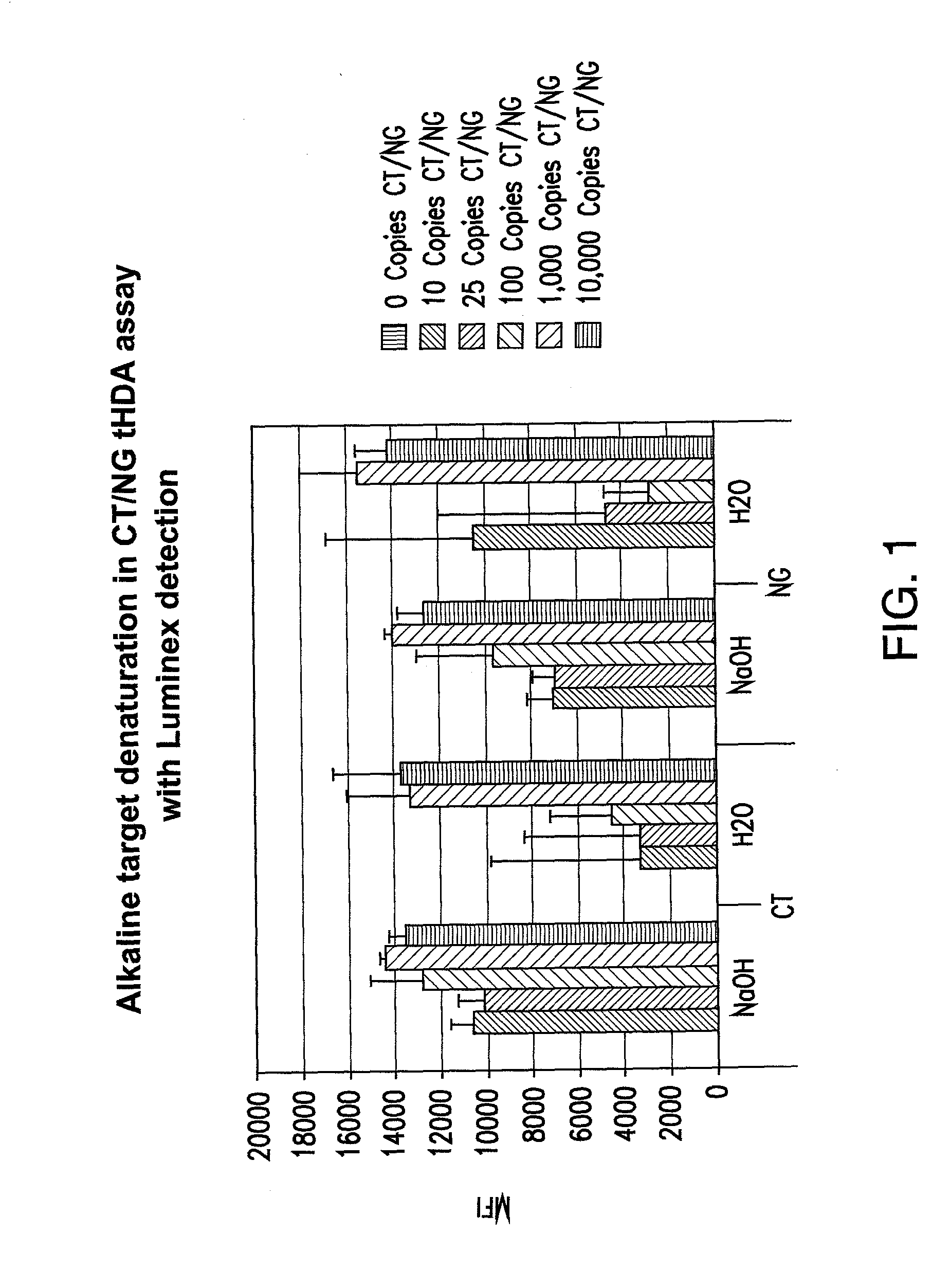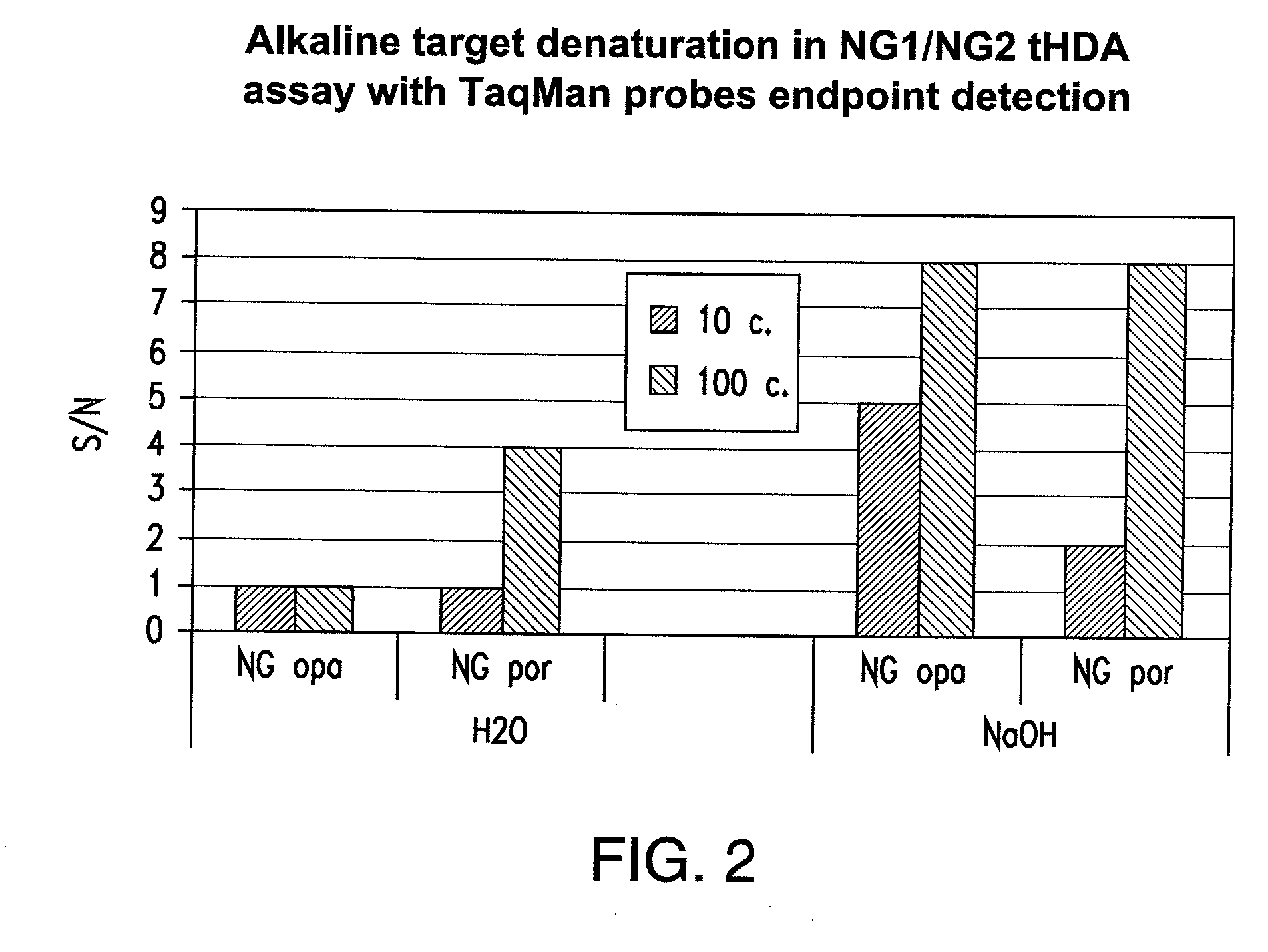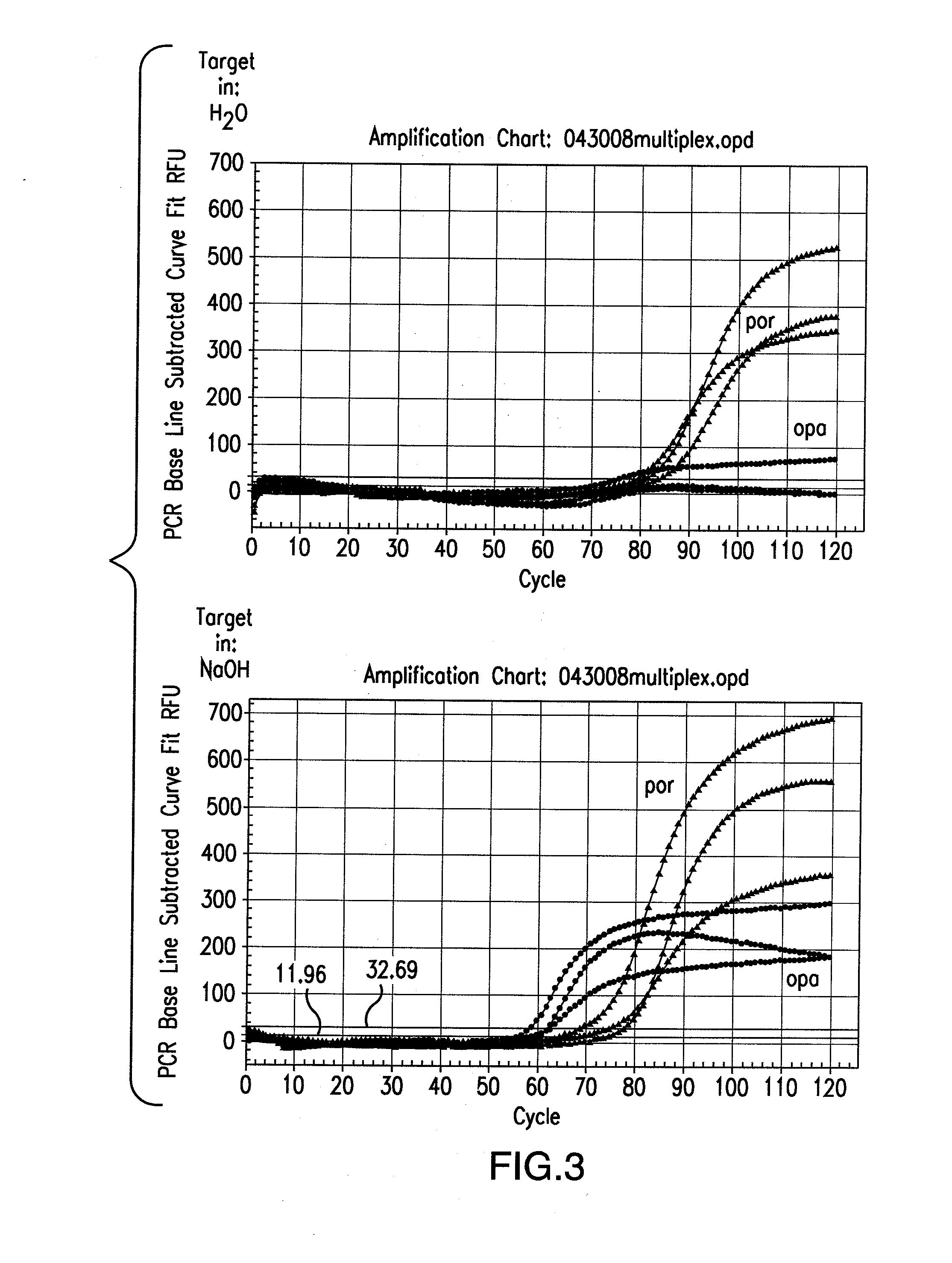Thermophilic helicase dependent amplification technology with endpoint homogenous fluorescent detection
a technology of fluorescent detection and helicase, which is applied in the direction of microorganism testing/measurement, fermentation, biochemistry apparatus and processes, etc., can solve the problems of ineffective thda at amplifying long target sequences, limited multiplication, and inability to obtain thda. to achieve the effect of improving the assay
- Summary
- Abstract
- Description
- Claims
- Application Information
AI Technical Summary
Problems solved by technology
Method used
Image
Examples
example 1
Alkali Target Denaturation
[0232]As helicase is able to unwind duplex DNA enzymatically, whether the entire tHDA reaction can be performed at one temperature at 65° C. without prior heat denaturation at 95° C. was tested. In addition, whether heat denaturation could be substituted by chemical alkali denaturation at 65° C. was also tested. Neisseria gonorrhoeae (NG) and Chlamydia trachomatis (CT) genes were chosen for the multiplex tHDA reaction as targets. Sodium hydroxide was added (example 1a.) to the CT and NG targets or to NG targets (example 1b.) and incubated at 65° C. for 10 min. For the control reaction, targets were diluted in H2O. Following target denaturation, the tHDA reaction was performed and specific targets were detected using either the Luminex assay (example 1a.) or the real-time and endpoint fluorescence detection (examples 1b. and 1c.).
example 1a
Evaluation of Alkaline Target Denaturation in CT / NG Multiplex Assay
[0233]The nucleic acid targets for this example were CT Cryptic Plasmid and NG Genomic DNA. To amplify CT in the tHDA reaction, ORF 3F and ORF 3R oligonucleotide primers were used (5′-ATCGCATGCAAGATATCGAGTATGCGT-3′ (SEQ ID NO. 185) and 5′Bio-CTCATAATTAGCAAGCTGCCTCAGAAT-3′ (SEQ ID NO. 186), respectively). To amplify NG in the tHDA reaction, opaD F and opaD R oligonucleotide primers were used (5′-TTGAAACACCGCCCGGAA-3′ (SEQ ID NO. 221) and 5′-TTTCGGCTCCTTATTCGGTTTAA-3′(SEQ ID NO. 222), respectively). The primer concentrations for the opaD F and opaD R were 30 nM and 75 nM, respectively.
[0234]The helicase preparation for the tHDA reaction also included MgSO4: 3.5 mM; NaCl: 40 mM; dNTP: 0.4 mM; dATP: 3 mM; Bst Polymerase; 0.4 U / ul; Helicase: 3 ng / ul; and Betaine: 1M. The reaction was carried out for 10 minutes incubation / denaturation in NaOH at 65° C.; 90 minutes amplification at 65° C.
[0235]The results from this experime...
example 1b
Comparison of Target Denaturation Method in a tHDA opa / por Multiplex Assay
[0236]In this experiment, two different target nucleic acid sequences were used to identify the presence of CT and NG (opa and por, respectively). To begin, Neisseria gonorrhea genomic DNA in concentrations of 0, 10, 102 and 105 copies / assay were individually diluted either in 0.1M NaOH or water and then denatured at 65° C. for 10 min. The Neisseria gonorrhoeae genomic DNA was then subjected to real-time tHDA. For the tHDA reaction, the helicase preparation comprised 3.5 mM Mg2+, 40 mM NaCl, 0.4 mM dNTP, 3 mM dATP, 5U rBST, 0.5U Helicase, 0.2M Betaine, and 1% DMSO. In addition, TaqMan Probes: OpaD b1_Tex; CGTCCTTCAACATCAGTGAAAATCG (SEQ ID NO. 132) conjugated to Tex615 and porA5_VD5_Cy5; CGCCTATACGCCTGCTACTTTCACG (SEQ ID NO. 133) conjugated to Cy5 (80 nM each) were also added to the helicase preparation.
[0237]opaDv F1—6 / R1 (SEQ ID NOS. 228 and 229, respectively) and porA F5 / R5 (SEQ ID NOS. 230 and 231, respecti...
PUM
| Property | Measurement | Unit |
|---|---|---|
| time | aaaaa | aaaaa |
| temperature | aaaaa | aaaaa |
| temperature | aaaaa | aaaaa |
Abstract
Description
Claims
Application Information
 Login to View More
Login to View More - R&D
- Intellectual Property
- Life Sciences
- Materials
- Tech Scout
- Unparalleled Data Quality
- Higher Quality Content
- 60% Fewer Hallucinations
Browse by: Latest US Patents, China's latest patents, Technical Efficacy Thesaurus, Application Domain, Technology Topic, Popular Technical Reports.
© 2025 PatSnap. All rights reserved.Legal|Privacy policy|Modern Slavery Act Transparency Statement|Sitemap|About US| Contact US: help@patsnap.com



